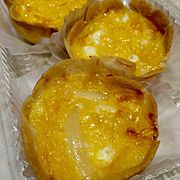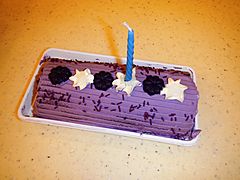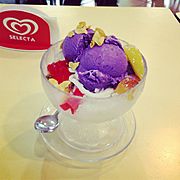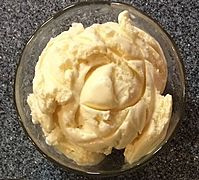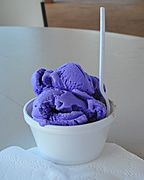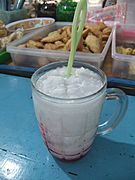Macapuno facts for kids
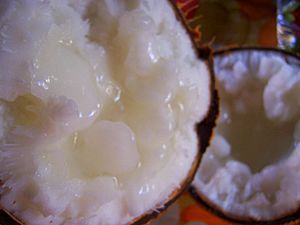
The endosperm of macapuno coconuts are jelly-like and fill almost the entirety of the central cavity in coconut seeds
|
|
| Alternative names | Coconut sport |
|---|---|
| Place of origin | Philippines (originally domesticated) |
| Region or state | Southeast Asia and the Pacific Islands |
| Associated national cuisine | Philippines, Indonesian |
| Main ingredients | Coconut |
Macapuno or coconut sport is a unique kind of coconut. It grows with a special, soft, jelly-like flesh inside. This soft flesh fills almost the entire coconut. There is usually very little coconut water in a macapuno.
Scientists first described macapuno in 1931. It became a popular crop in the Philippines in the 1960s. This happened after a new way to grow them was invented. Today, macapuno is an important food in many coconut-growing countries. It is used a lot in foods across Southeast Asia and the Pacific Islands.
Contents
What's in a Name?
The name macapuno comes from the Tagalog word makapuno. This word means "characterized by being full." It describes how the soft inside of the macapuno coconut fills up the whole shell.
In Indonesia, it is called kelapa puan, meaning "female coconut." This refers to its softer texture. Another Indonesian name is kelapa kopyor, which means "scrambled coconut." This name describes its white, yellowish, and "cluttered" look.
Macapuno has other names too. In Cambodia, it's dong kathi. In Thailand, it's maprao kathi. In Vietnam, it's dừa sáp, meaning "wax coconut."
Special Features of Macapuno
You cannot tell a macapuno coconut from a regular one just by looking at the outside. The only way to know is to open it up!
Regular coconut flesh is mostly made of a substance called galactomannan. This substance is usually broken down by a special enzyme. But in macapuno, this enzyme does not work correctly. This means the galactomannan isn't broken down. This is why the inside of the macapuno becomes soft and jelly-like.
Macapuno coconuts have more sugar than regular young coconuts. They also have more amino acids. These things help give macapuno its unique and delicious taste.
Scientists group macapuno into three types. These types depend on how much of the soft, jelly-like flesh fills the coconut.
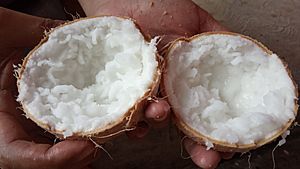
How Macapuno Grows
Macapuno is caused by a special recessive gene. Think of it like a hidden trait. For a coconut to be macapuno, it needs two copies of this special gene.
Naturally, macapuno palms often grow both macapuno coconuts and normal coconuts. This is because the palm itself might carry one copy of the special gene and one copy of a normal gene. When it passes on two copies of the special gene, you get a macapuno coconut.
Macapuno coconuts cannot grow into new trees on their own. Even though the tiny plant inside (the embryo) is normal, the soft, jelly-like flesh around it cannot help it sprout. This means macapuno seeds are usually sterile.
History of Growing Macapuno
Macapuno coconuts are naturally very rare. Only about 0.15% of coconuts in the wild are macapuno. They were first written about by a scientist named Edwin Copeland in 1931. He found them in the Philippines and Indonesia.
Because macapuno seeds couldn't sprout, it was hard to grow many of them. People tried planting normal seeds from macapuno-bearing palms. But the chances of getting macapuno coconuts from these trees were very low.
Then, in the 1960s, a Filipina plant scientist named Emerita V. De Guzman made a big discovery. She developed a method called "embryo rescue." This method allowed her to take the tiny plant (embryo) out of a macapuno seed. She could then grow it in a lab. This amazing discovery meant that macapuno palms could produce 75% to 100% macapuno coconuts!
Later, in the 1990s, another Filipina scientist, Erlinda P. Rillo, improved this method. Now, "embryo rescue" is the main way to grow many macapuno seedlings in countries that produce coconuts.
Culinary Uses
Macapuno is very popular in Filipino cuisine. People love its sweet coconut flavor. You can eat it plain, or use it in traditional desserts.
- Halo-halo: A popular shaved ice dessert with many ingredients, including macapuno.
- Pastillas: Sweet milk candies often made with macapuno.
- Minatamis: Macapuno cooked in syrup, like a fruit preserve.
It's also used in ice creams, cakes, candies, and drinks. A classic Filipino flavor combination is macapuno with ube halaya (mashed purple yam). This is called "ube macapuno."
In Indonesian cuisine, macapuno (called kelapa puan or kopyor) is a special treat. Es kelapa kopyor is a dessert drink made with it. The simple version has just the macapuno, sugar, ice, and water. This lets you taste the coconut's unique flavor.
In Vietnam, macapuno is grown in certain provinces. It is an expensive delicacy there. People often mix its flesh with milk and crushed ice to make a smoothie. They serve it with crushed peanuts on top.
-
Macapuno tarts from the Philippines
-
Macapuno pastillas from the Philippines
-
Ube macapuno pianono from the Philippines
-
Halo-halo with macapuno strips from the Philippines
-
Macapuno ice cream in California
-
Es kelapa kopyor from Indonesia
vi:Dừa sáp


